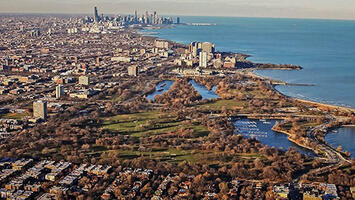
Here’s part 5, the last entry of my “Tottering Chicago?” series. In case you didn’t know or had forgotten, this series was prompted after reading William Voegeli’s That Tottering Town, a review of the book What Next, Chicago? Notes of a Pissed Off Native Son by Matt Rosenberg. Both pissed me off enough to kick off the series – to call out the flaws and establish a framework for the revitalization of cities like Chicago. This is the last in the series, where I’ll consider what’s next for Chicago and cities like it.
For the others in the series:
So here we are. There’s one last question to tackle -- What really lies ahead for Chicago, or any non-coastal or non-Sun Belt city?
First, let’s put that question in the appropriate context. There are a couple things that regularly frustrate me when people discuss cities, and it particularly hurts cities that don’t fit the paradigm of the day. For example, I assess current trends in urbanism as much as anyone. I make educated guesses on their future impact on cities. I also love urban history and try my best to incorporate bits of history into the pieces I write. There is much to be learned from how cities addressed similar challenges throughout history. However, I’m continually frustrated by what I see as urbanists’ focus on the here and now. It distorts our perception of cities.
We put too much stock in current conditions. We overreact to the meaning and potential impact of things happening right now, without ever really considering that cities may have faced – or even conquered – similar challenges before. Too many of us want to look at things as they are right in front of us, without establishing any kind of broader context. That’s a recipe for disaster.
Recent examples abound. Ever since the onset of the Covid pandemic, which led to the outflux of many (particularly affluent) city residents to less-populated areas, there was a rush to judgement that cities were on the verge of collapse because of the virus. The rise of the work-from-home phenomenon over the same period also was to spell doom for the downtowns and commercial centers that depended on influx of daily commuters; what will we do with the vacant office space? Who will shop at commuter-dependent businesses? Today’s housing affordability crisis is undermining the very foundation of cities and causing residents to flee for less expensive places. Rising violent crime has impacted cities nationwide, not just Chicago, and Republican candidates for office have used the fear of spreading crime to motivate voters.
Relatedly, it’s useful to remember that the history of cities goes beyond what’s happened in the last 50 years, or since World War II, or since the Industrial Revolution, or since imperialism and colonialism. Historically, cities have been remarkably resilient and adaptable, reinventing themselves at various junctures. Today’s urbanists might believe that cities reach a population and economic peak during one era, yet precipitously decline during another, and become forever doomed. That’s not always the case. Some never return to their former glory, but others rise to new heights that surpass where they were before.
Consider a couple of Roman era capitals. Istanbul (Constantinople) maintained a population of around 500,000 when it was the capital of the Eastern Roman Empire; the fall of the Empire and subsequent invasions dropped the population to an estimated 50,000 at the onset of the Ottoman Empire in 1453. Istanbul has grown since to become Europe’s largest city with more than 15 million residents. London had about 50,000 – 100,000 people during the period of Roman rule but was effectively abandoned for much of the Middle Ages. London eventually reclaimed its place as the largest city in England in the 11th century, morphing into the national capital and global city of 9 million people today.
Need more recent examples? Milan and Hamburg are cities that experienced recent decades of population loss and later rebirth. Milan reached a peak population of 1.7 million in 1971 and lost nearly 500,000 residents over the next 40 years. A 2019 estimate showed the city grew by 13 percent between 2011 and 2019. Hamburg peaked at 1.8 million in 1961 and eventually suffered a more modest decline, losing 250,000 people (approximately 14 percent) over the next 25 years. Hamburg’s been steadily growing since the 1980’s and as of 2021 passed its previous peak.
That being said, there’s an even broader frustration I have with today’s urbanism, and I alluded to it in the first post of this series. America’s coastal city issues have been “solved”, in the sense that they’ve been able to rely on a knowledge-based global economy to change their fortunes. America’s Sun Belt cities found a solution as they marketed their affordability, climate, lower taxes and business costs to draw residents.
But there’s been no solution put forth for the nation’s Rust Belt cities, including Chicago, which lack strong connections to the knowledge-based parts of the global economy to rise the way coastal cities have, or climate or cost structure to compete with Sun Belt cities.
Read the rest of this piece at Corner Side Yard Blog
Pete Saunders is a writer and researcher whose work focuses on urbanism and public policy. Pete has been the editor/publisher of the Corner Side Yard, an urbanist blog, since 2012. Pete is also an urban affairs contributor to Forbes Magazine's online platform. Pete's writings have been published widely in traditional and internet media outlets, including the feature article in the December 2018 issue of Planning Magazine. Pete has more than twenty years' experience in planning, economic development, and community development, with stops in the public, private and non-profit sectors. He lives in Chicago.
Photo: An aerial view of Jackson Park and Chicago's South Side. Source: urbanmatter.com












